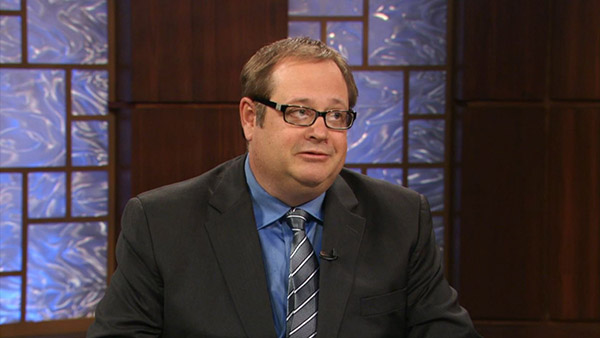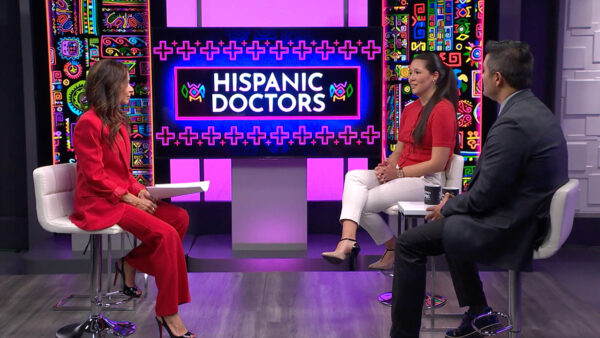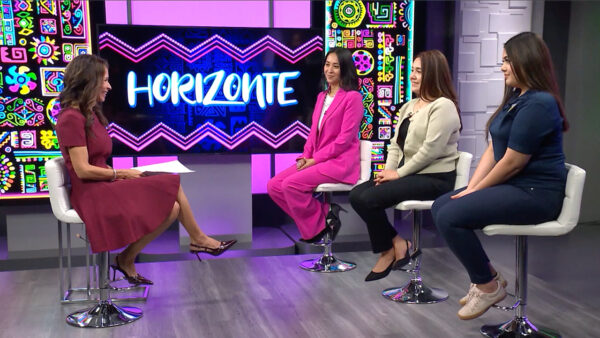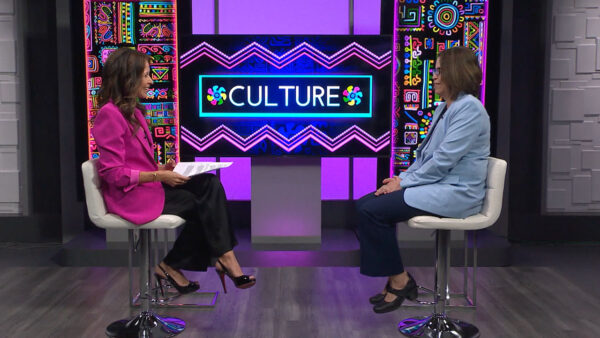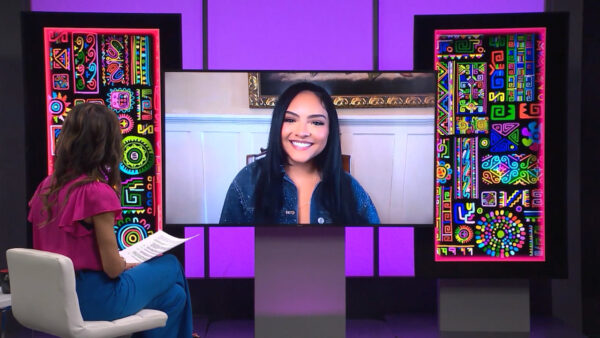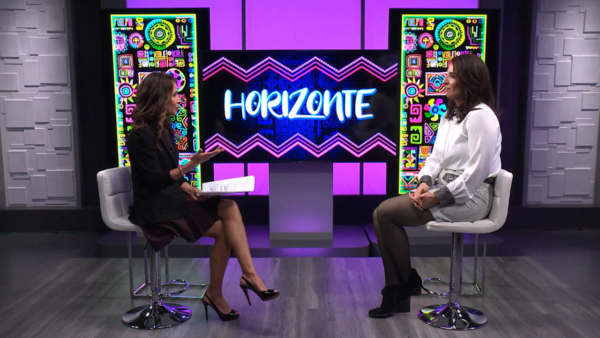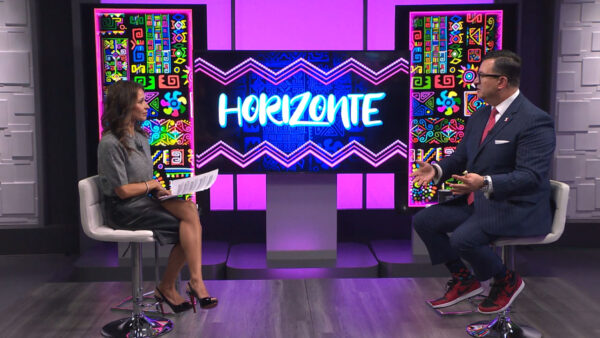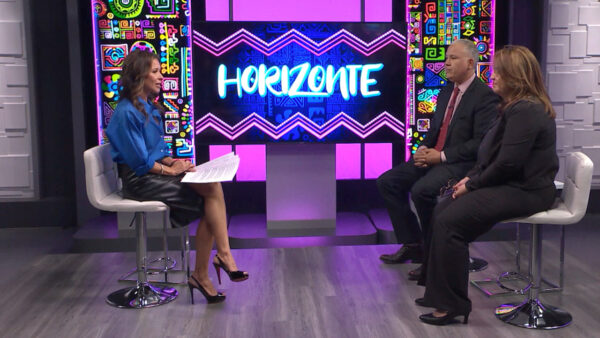Guest: Tommy Espinoza, President & CEO of Raza Development Fund (RDF) Chase, the retail banking unit of JP Morgan Chase & Co., announced a $1 million grant to National Council of La Raza (NCLR) and its community development subsidiary, the Raza Development Fund. Raza Development Fund is the nation’s largest and most successful Latino Community Development Financial Institution in the country. RDF will use the grant money to help NCLR-affiliated community-based organizations around the country in purchasing and developing land for affordable housing, charter schools, community child and health care centers, including a project in South Phoenix. The rest will go to home-buyer and general financial education.
>>José Cárdenas:
Good evening, I'm José Cárdenas. Tonight on "HORIZONTE", a new national grant is announced to help boost development in Hispanic communities. And the Fiesta and Insight Bowls put the valley into the national spotlight. Tonight, you'll meet the man in charge of the planning process and making it all happen. That's next on "HORIZONTE".
>> "HORIZONTE" is made possible by the friends of Channel 8, members who provide financial support to this Arizona PBS station. Thank you.
>>José Cárdenas:
The college football bowl games and festivities are coming to the valley in a couple weeks. Since 1971, the Fiesta Bowl has generated more than $1 billion to Arizona's economy. A recent study taken in 2003 showed the Insight Bowl brought in over $20 million to Arizona. Joining us to talk more about these events is the chairman of the board for the Fiesta Bowl and chairman for the Insight Bowl, Armando Flores. Armando, thank you for joining us tonight on "HORIZONTE".
>> Armando Flores:
Thank you, nice to be here.
>>José Cárdenas:
Give us a thumbnail sketch of the history of the Fiesta Bowl. We know it started in 1971, it's generated a lot of money, but it's really grown
over that time, hasn't it?
>> Armando Flores:
It was started by 7 or 8 gentlemen who had an idea of giving Arizona state a place to play after the season was over. That was sort of the cornerstone of the concept. And since then, to your point, it has grown tremendously to the point where today it's one of the four major BCS bowls in college football.
>>José Cárdenas:
That's the Bowl Championship Series.
>> Armando Flores:
That's correct.
>>José Cárdenas:
Which has generated quite a bit of controversy in recent years.
>> Armando Flores:
Probably not more than this year.
>>José Cárdenas:
Tell us a little about the selection process.
>> Armando Flores:
Basically, the way it works although there's a lot of caveats to this. There are 6 BCS conferences. The rules say if you win your conference, if you happen to be in one of those BCS conferences, you get to go to a BCS game. That takes care of 6 teams in a 4 game BCS series. The other two teams are selected at large, unless there is a non-BCS team that goes into the top 6 in the final ratings by the, in the BCS polls as was done by Utah this year.
>>José Cárdenas
: Let's talk about the two teams in this year's bowl. Utah and who else?
>> Armando Flores:
And university of Pittsburgh.
>>José Cárdenas:
What was the process by which they were selected for the Fiesta Bowl?
>> Armando Flores:
The University of Pittsburgh satisfied the criteria for winning a conference there. In the big east, they won their conference, and they automatically get a bowl championship series opportunity.
>>José Cárdenas:
During the course of the year, you spend, along with other Fiesta Bowl volunteers, a lot of time scouting out games, is that right?
>> Armando Flores:
That's correct. Scouting out games and building relationships with athletic directors across the country in division one schools, some coaches and university presidents.
>>José Cárdenas:
How long have you been involved with the Fiesta Bowl?
>> Armando Flores:
I was involved back in 1996, '97, in that time frame. My first year as a volunteer. I escorted the Kansas State University president up to the Grand Canyon with his family that year on very short notice. And from there, I went on, became a member of the committee, was a member of the committee for three years and have been on the board of directors for five.
>>José Cárdenas: When did you become chairman?
>> Armando Flores: January of this year I started my official term as chairman of the board.
>>José Cárdenas:
How long will that term be?
>> Armando Flores:
One year.
>>José Cárdenas:
What's involved in being chairman?
>> Armando Flores:
I'm not sure I can remember all the things, but picking all people for the key positions, all of the chairs and co chairs of the committees for all of the events and activities that we put on. In addition, selecting and nominating board members to fill spots that have come open, picking a committee chair and then overseeing those chairs and assistant chairs as they begin to plan out the process for putting on over 50 events during the last two weeks of the year.
>>José Cárdenas:
It's quite a major undertaking and yet you also have a day job, don't you?
>> Armando Flores:
I have a day job.
>>José Cárdenas:
That is?
>> Armando Flores: Executive vice president with Arizona Public Service Company.
>>José Cárdenas: As I understand, you're one of the senior executives of the company?
>> Armando Flores: Probably so.
>>José Cárdenas:
Just a real thumbnail sketch of your duties they're at APS.
>> Armando Flores:
I have responsibility for many of the support areas, for example, information technology, human resources, all of communications, public relations, media relations, etc. Many of the support areas that provide support to the operating side to the business.
>>José Cárdenas:
I know you are very involved in the community and education and everything, and if we have a little bit of time at the end of the interview, I'd like to talk about that. First, what does the Fiesta Bowl mean to the valley? It's grown much more than just a football game.
>> Armando Flores:
I think it means multiple things. I think, first of all, it means an opportunity, not only the football games but certainly via the over 50 events that we put on for people not only from the valley but the State of Arizona to participate in one or more of those events and enjoy the festivities that go along with those particular events. One of the largest, of course, is the Fiesta Bowl parade, which draws approximately 400,000 people to the streets of downtown Phoenix every year. It also means a major economic stream for the State of Arizona.
>>José Cárdenas:
How much money are we talking about?
>> Armando Flores:
I think in terms of impact we're probably talking in excess of $55 million on a conservative level.
>>José Cárdenas:
About a billion dollars since it's been in existence.
>> Armando Flores:
As the bowl has grown, so have the revenues grown.
>>José Cárdenas:
What does this mean in terms of the image of Arizona projected each new years day?
>> Armando Flores:
Everybody knows about our weather but it illuminates our weather to the rest of the United States, it provides a reason for people to come out and enjoy some of the festivity, vacation at the same time, come early, stay late and give the hospitality industry a shot in the arm in terms of the revenues that they enjoy from visitors from outside of Arizona.
>>José Cárdenas: You're going to have a great match-up this year but even in years where you might not, as I understand it it's really become an event that's sold out no matter who is playing in the game. Is that true this year, too?
>> Armando Flores:
If you contrast last year, we had the national championship, Ohio State and Miami, we had standing room only. This year as of Monday, which is not a championship year, we sold 73,056 in a stadium that has a capacity of 73,000.
>>José Cárdenas:
When are you going to talk to the 56 people?
>> Armando Flores:
There is always a little bit of elasticity there because we know there are always people that don't show up, changes that occur that will accommodate the 56 people plus.
>>José Cárdenas:
The portion that goes to ASU, how is that used?
>> Armando Flores:
Let me first say that when a conference team, namely the Pac-10, which ASU is a part of wins a bowl game, they divide the proceeds in 10 equal parts in the universities and the parts making up the 10. With USC going, and part of the BCS, they will get 14 to $17 million and that revenue will be split up equally among the ten teams in the Pac-10. In a like manner -- so ASU will get money from USC going to the national championship. Any other Pac-10 team that goes to a bowl game, those proceeds will also be split. In addition, we use the facilities, Sun Devil Stadium being the major facility, and we pay ASU approximately $250,000 a year just for the use of their facilities. In addition, periodically we will make a donation, this year we made an unsolicited donation of $200,000 to the athletic director Gene Smith for educational resources for his athletes.
>>José Cárdenas:
What is going to happen when the Fiesta Bowl moves to the new Cardinals stadium? That would be 2006.
>> Armando Flores:
With the game played in January '07 which is really the '06 game, the only thing that will happen is that the venue will change. All of the activities that we put on now will continue to be the same and hopefully we'll have a much more current venue to put the, put on the Fiesta Bowl football game.
>>José Cárdenas:
You also chair the Insight Bowl. Tell us who is playing and what we can expect from this.
>> Armando Flores:
The Insight Bowl changed from the Copper Bowl when it was originally in Tucson. We felt after a few years in Tucson it was -- didn't really have the opportunity to grow as quickly as we would have liked it to grow in terms of participation, in terms of stature, so we moved it to Phoenix and had the game staged at Bank One Ballpark. The people came out and really supported the game. We average 41 to 43,000 people per game. And this year, that game is also already sold out with Notre Dame and Oregon State playing in this year's Insight game.
>>José Cárdenas:
Which is a repeat of a match-up of a few years ago.
>> Armando Flores:
Very good. Yes, that's true.
>>José Cárdenas:
Expecting a good game?
>> Armando Flores:
Expecting a good game.
>>José Cárdenas:
Tell us about some of your more unusual experiences you've had in your years as chair or some of the years you've been a volunteer for the Fiesta Bowl.
>> Armando Flores:
It's all unusual. I've been traveling since August. I've only been home one weekend since August because I've been traveling all across the country. Some of the highlights of my travel, one was the pep rally at Notre Dame. I've never seen anything like it. 10,000 people, standing room only, in their basketball venue chanting the night before for their team and for their team's success the next day. Followed by 82,000 in a sold out stadium every game on the campus in South Bend. It's something; just being at the game is incredible. Being at the pep rally you can't hear anybody who is yelling at the top of their lungs sitting next to you, it's that loud. It's an incredible following that they have. Basically, 98 to 99% of the students attend the pep rally and the game.
>>José Cárdenas:
Presumably they'll be out here this year. Armando Flores, thank you for joining us.
>> Armando Flores:
Thank you for having me, Jose. Appreciate it.
>>José Cárdenas:
Chase, the retail banking unit of J. P. Morgan, Chase and Company, recently announced a $1 million grant to the National Council of la Raza and its Phoenix-based community development subsidiary, The Raza Development Fund. This money will go toward financial education for people and into buying land for developing Latino community projects around the country. We'll talk more about this grant in a moment, but first Mike Sauceda tell us more about The Raza development fund's mission.
>> Mike Sauceda: La Raza development Fund, Incorporated, also known as RDF, was established in 1998 to provide capital and development assistance to the National Council of La Raza and their nationally affiliated Latino organizations. The mission of RDF's hope fund is to provide flexible but high quality loans along with technical assistance to entities that provide services and opportunities to low income Latino families. Since it began, RDF has become the largest Latino community development financial institution in the United States. RDF's hope fund is unique in several ways. It is not confined to any geographic area, but is focused on the local organizations, community development, a commitment is to provide full range of development assistance and financing in all phases of community development projects. RDF has financing and underwriting flexibility to help a local community developer, address collateral or equity requirements and adequate debt and service coverage. This is done in the following ways: Offering recoverable grants for predevelopment, as well as low interest loans from the hope fund for facilities development, and subordinate loans and equity investments. Currently, RDF has approved loans totaling over $50 million.
>>José Cárdenas:
Joining us is Tommy Espinoza. He is president and chief executive officer of The Raza Development Fund. Tommy, welcome to "HORIZONTE".
>> Tommy Espinoza:
Thank you, Jose.
>>José Cárdenas:
You are a familiar face to our viewers because you have been in the valley for a long time in a variety of activities. Give us a thumbnail sketch what you have been doing in recent years.
>> Tommy Espinoza:
Recent years, I was blessed to get a request from the president of the National Council of La Razza to come to Washington D.C. to help reengineer the National Council of La Raza's community development technical assistance efforts. I spent about four years in Washington back in '97 to about the year 2000 and enjoyed that whole rat race. But in the process, we formed the hope fund, which is really La Raza development fund and that experience was to some degree interesting enough during that period of time I was reading a lot of Mother Teresa. I took the religious piece what she had created but if you look at her organization, it is an international community development corporation.
>>José Cárdenas:
So Mother Teresa's work is your financial model?
>> Tommy Espinoza:
Exactly. She focused on the poorest of the poor, for the moment that was her customer. What was amazing about her, as she started to do her work in serving, whether it was the children, she started a preschool, when dealing with the lepers, they started a clothing plant that provided clothing for the lepers. That then turned into a plant that provided employment. When you start to look at the things she was doing, obviously, for spiritual reasons, but ultimately she was forming an international community development organization.
>>José Cárdenas:
Who are La Raza's development funds customers?
>> Tommy Espinoza:
Our customers are Hispanic families. There's a paradigm shift from the traditional community development approach. And we looked at an organization; we measure whether they're really impacting the community they say they're representing. And therefore, we look to see there's going to be the children impacted by charter schools or a preschool. They're building single family homes but they are going to be serving the poor families in that community. If it's multi family units that they're going to build it in a place where we need it. We look at our partners, the CDCs as we like to call them.
>>José Cárdenas:
Community development corporations.
>> Tommy Espinoza:
Chicanos por la Casa, Friendly House, to give you an example locally of the type of organizations, they are partners. The relationship changes. It's one of mutual respect, and to some degree financial and contractual arrangements between us that we are going to go into a project that impacts the community.
>>José Cárdenas:
This is a slightly different relationship than the one NCLR, la Raza, has with organizations like CPLT?
>> Tommy Espinoza:
National Council of La Raza is an advocacy organization also a provider. So NCLR is more -
>>José Cárdenas:
Technical assistance?
>> Tommy Espinoza:
Right. They go in help with the board of directors, with the kinds of services that they need to provide. Obviously, Washington corporate offices for NCLR, education, health, immigration, all the issues that impact Hispanics are in one way or another usually tied back to community development.
>> Jose Cardenas:
How does that differ from what La Raza development fund focuses?
>> Tommy Espinoza:
We are a bank. We are licensed by the treasury. We are a community development financial institution. We do not take deposits, so to some degree we are different from a regular bank, but we end up borrowing capital. Most banks borrow capital from treasuries or deposits, Where we end up borrowing from banks. So once we put together a relationship, a partnership with one of the banks, what's called a CRA, reinvestment act, it allows them to use us -- for instance, if they lend us $50 million over a 5 year period of time, they get to use that as their CRA effort in the community nationwide because of the license that we hold.
>>José Cárdenas:
As I understand it, there are a whole bunch of different things that make La Raza development fund unique, one being that it's the only national bank owned and controlled by Hispanics. What other things set the fund aside from other national banks?
>> Tommy Espinoza:
Jose, I would tell you we are the largest Hispanic and only national community development bank in the country. The real difference is that we roll up our sleeves and work with the organization to really measure the impact and assist them in thinking through whether they should borrow capital. What we don't talk about most of the time in our write-up is that we can't make a loan to every organization and many times as we go in and assist them in the due diligence process of looking at a project, sometimes they will come to the conclusion we shouldn't borrow money from you because ultimately it may take us off course from what we're trying to serve the community with or regardless of how much soft capital we put into this, it's not going to work. That's a difference between a bank that will say yes or no for a lot of regulatory reasons, they're not going to get too far into a transaction. Legally they're not going to do that, also, because realistically if you get too close to a loan, you ultimately can be sued for being part of the transaction. That's not a concern of ours, we don't look at that. Most of our transactions are not bankable. In other words, if you into Chase or Bank of America or CitiGroup, with a loan package and you look at our deals -- ultimately, we lower the interest rates, we put equity capital versus debt to make it work.
>>José Cárdenas:
The Chase grant, what impact will that have?
>> Chase Bank, they really are taking a risk with us. The initial relationship is a million-dollar grant. $750,000 of that capital is going to be used to underwrite purchasing land. Most -
>>José Cárdenas:
Here in Maricopa County?
>> Tommy Espinoza:
Here in Maricopa County, in Arizona and across the country. It will be one of the pilots obviously here in Phoenix in the valley. But it allows an organization in a hot real estate market like in Maricopa County if they see a piece of property that they've been looking at either to expand a charter school or to build some single family housing or to build an apartment complex, we'll step in and assist them in taking the land down, basically to purchase the property. This capital is just really for what we call the hardest part of the capital. The 700,000 should leverage, we hope another 25 million in real deals. So we will use that money as that piece that gives you the equity piece that makes the deal work. Now, Chase is committed to more on a 50 to $100 million relationship with us over the next five to 10 years in transactions that we would provide them across the country that mainly are in the real estate area. Most of our groups are dealing with projects that are brick and mortar.
>>José Cárdenas:
One of the uses will be for financial education of Latino families. Can you talk about that a little bit?
>> Tommy Espinoza:
I'm glad you hit on that, Jose. One of the things that is becoming very evident to us is obviously all the statistics show the numbers are growing and we are the largest minority in the country and so on, but if you look at our assets buildup and the kind of capital that we have, within our own community that's not being properly used to build wealth. This capital, the quarter of a million dollars that's going to be on the National Council La Razza side will be to put together what we are calling economic mobility centers that will start and obviously partnering with our affiliates that will teach families within poor communities how do you look at interest rates, if you're going to buy a home, make sure you're not going to a predatory lender who may be charging you 18% rates, when the interest rates are at the lowest in 30 or 40 years. And how do you develop a credit standing. Any more, it's not so much money you have for a down payment, but what your credit rating is that will allow that interest rate to go lower. We found that is a real need across the country, so that will be occurring and there will be an economic mobility center here in Phoenix.
>>José Cárdenas:
How many people do you think will be served?
>> Tommy Espinoza:
The numbers depend on the organization. We found, for instance, the Spanish speaking community council in Oakland, they run thousands of people through their program. There are other advantages. There are tax benefits for families that are low income, that they should get a refund if they apply for it and many families are not aware of it. There have been a number of groups across the country that generated thousands of dollars back to families just by helping them putting a tax return back to the IRS.
>>José Cárdenas:
You mentioned predatory lending which has been a focus of Attorney General Goddard as it affects the Hispanic community in particular.
>> Tommy Espinoza:
We have found, Fannie Mae has statistics that a large number of housing that has been purchased over the last couple of decades have been Hispanic families and a large number fall into predatory lending where you have a mortgage company and some of the big banks, I won't mention them, where the interest rate is higher to Hispanic and Afro-American Families. Most of the time, they're not based on their credit score. Sometimes it's looked at when they are on the line. The line may mean that they haven't borrowed money. Which means they are just looking at the history of the family. They're not taking into account that many Hispanics do not like debt so they buy everything with cash. Or if they have been living in an apartment, sometimes the receipts that they keep historically don't track them very closely. There's been some flexibility put in, especially with Fannie Mae and Freddy Mac at looking at credit history differently than they have in the past.
>>José Cárdenas:
Tommy, we have 30 seconds left. Final thoughts on what the grant means to the fund.
>> Tommy Espinoza:
It's an opportunity to open our groups to purchasing from good pieces of property for future development for our community, especially for Hispanics.
>>José Cárdenas:
Tommy Espinoza, thank you for joining us on "HORIZONTE".
>> Tommy Espinoza:
Thank you.
>>José Cárdenas:
To see a transcript of tonight's show or see what's coming up on "HORIZONTE", go to our website at www.az.pbs.org and click on "HORIZONTE". Thank you for joining us tonight. I'm José Cárdenas. Have a good evening.
Tommy Espinoza: President and Chief Executive Officer, The Raza Development Fund;
